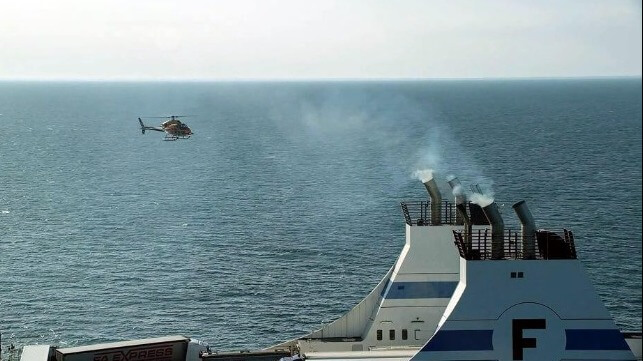Study Uses Drones and Helicopters to Measure Methane Slip in Service

Methane slip remains one of the most hotly debated elements in the use of liquified natural gas as an alternative fuel both in the maritime industry as well as other sectors. In a first-of-its-kind, year-long study a team of researchers plans to measure the amount of methane escaping into the atmosphere both unburnt in ship exhausts as well as from storage and fuel tanks along the supply chain. The organizers of the project, known as FUMES, believe the data provided will be useful for a variety of policymakers, including at the International Maritime Organization and the European Union, as they consider ways to establish and enforce limits on methane emissions from LNG-fueled ships.
The FUgitive Methane Emissions from Ships (FUMES) project is being led by the International Council on Clean Transportation (ICCT) in collaboration with Danish-based Explicit ApS and the Netherlands Organization for Applied Scientific Research (TNO). Measurements will be taken in 2022 and the team will publish a peer-reviewed, publicly available white paper in 2023.
The project seeks to become the first comprehensive study into methane slip. The organizers note that despite the concerns about methane emissions and the potential to negate the GHG reduction benefits of using LNG compared to conventional fuels, the current literature on methane emissions consists of only a small number of studies based on limited measurements taken on board ships or in a laboratory.
“Obtaining this real-world data will help us to better understand the conditions under which methane emissions from LNG-fueled ships are high or low, and that’s important when considering ways to reduce the environmental impacts of shipping,” said Bryan Comer, Ph.D., marine program lead at the ICCT.
FUMES will assess emissions from ship engines and fugitive emissions from fuel tanks and cargo tanks. They will employ a variety of methods to take the measurements, including using in-stack continuous emissions monitoring, drones, and helicopters to examine and quantify methane emissions from ships under a variety of real-world operating conditions at a scale never before achieved.
“In addition to onboard measurements, the project will deploy both drones and helicopters to sample exhaust plumes from many more ships to provide broader insights into the factors that affect methane emissions. We will also use new drone-based technologies to quantify total fugitive methane emissions from ships, something which has never been done before,” said Bettina Knudsen, COO/CMO of Explicit ApS.
As part of the study, they will qualify the measurements related to the engine technology with a focus on emissions from low-pressure dual-fuel engines and high-pressure dual-fuel engines. FUMES results are expected to include estimated methane (CH4) and nitrogen oxides (NOx) emission factors by engine type for the ships measured.
Trade groups and engine manufacturers argue that there have been significant advancements in the design and operation of LNG-fueled engines as well as the processes to support the operations. They contend that new generations of engines have largely eliminated methane emissions from operating ships while other organizations, including the World Bank, discounted the potential of LNG due to the harm from methane emissions.
“Improvements in engine design over recent years might not be fully captured in older studies, and so that’s another gap in the literature this project will help address,” said Robin Vermeulen, engine and emissions measurement specialist at TNO.
The organizers also cited the importance of developing this comprehensive analysis due to the increasing adoption of LNG as the maritime industry seeks to begin to decrease its carbon emissions and met restrictions being adopted by a broad range of regulators. The organizers of the study estimated that the global use of LNG as a marine fuel grew nearly 30 percent between 2012 and 2018. They note that LNG is becoming especially popular as a fuel for new cargo ships and cruise ships.
